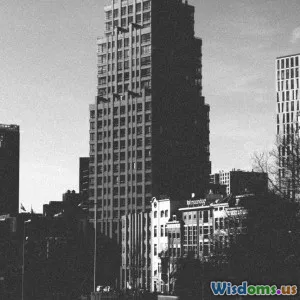
Five Common Myths About the Birth of Skyscrapers
8 min read Debunking five myths about skyscraper origins to reveal true history and innovation in urban architecture. (0 Reviews)
Five Common Myths About the Birth of Skyscrapers
Skyscrapers dominate modern urban landscapes, yet their birth is often clouded by myths and misconceptions. Tall buildings inspire awe and drive economic growth, but how well do we really understand their origins? This article debunks five widespread myths about the birth of skyscrapers, revealing the truth behind one of humanity's most impressive architectural feats.
Myth 1: Skyscrapers Began with Steel Frame Construction in Chicago
Many credit the birth of the skyscraper to the early steel-framed buildings erected in Chicago, especially the Home Insurance Building (constructed 1884–1885). While Chicago was undeniably pivotal in skyscraper history, the idea that steel frame construction invented the skyscraper is an oversimplification.
The Reality:
The Home Insurance Building is often hailed as the "first skyscraper" largely because it introduced a metal frame to reduce wall thickness and support additional floors. However, this structure used a hybrid of structural steel and wrought iron—not purely steel—as well as heavy masonry on lower levels. Furthermore, metal skeletal frames had been experimented with earlier in France by engineer Auguste Perret in the 1890s, and other European prototypes explored framed structures shortly after.
Example: The 1897 Perret Tower in Paris showcased reinforced concrete framed construction, indicating that skyscraper technology evolved in parallel both in Europe and the U.S. alongside the Chicago School.
Insight: The Chicago ingenuity was adopting evolving tech pragmatically rather than inventing steel-frame skyscrapers outright.
Myth 2: The Elevator Did Not Influence Skyscraper Development
It's often believed that early tall buildings were limited by elevator technology or that elevators simply followed the rise of skyscrapers. Some imagine early buildings had to be kept short because patrons refused tall ascents via stairs.
Truth:
The safety elevator invented by Elisha Otis in 1853 was a pivotal enabler for skyscrapers. Without reliable, safe elevators, buildings taller than five or six floors would be impractical for modern offices or residences.
Fact: Otis's invention of the safety brake, which prevented cable failures from catastrophic falls, triggered a vertical expansion boom in cities.
Real World Impact: By the 1870s–1880s, commercial buildings integrated elevator banks that allowed previously unthinkable heights to become accessible and commercially viable. The Woolworth Building in New York (completed in 1913), was a landmark skyscraper largely possible through advancements in elevator design and speed.
Quote: Otis (paraphrased): "Men will not consent to occupy the upper floor unless some mechanical means is provided to place them there."
Myth 3: Skyscrapers Were Designed Solely for Aesthetic Monumentality
Popular opinion sometimes holds that architects designed the earliest skyscrapers merely to impress and demonstrate power through imposing height and ornamentation.
The Practical Truth:
Early skyscraper architects had to balance structural integrity, fireproofing, usability, and cost-efficiency. Although aesthetics played a role, practical demands fundamentally shaped design.
Case in point: Louis Sullivan, often called the "father of skyscrapers," famously declared "form follows function." His designs—such as the Carson, Pirie, Scott Building in Chicago—focused less on decorative excess and more on usable interior floor space, natural light, and efficient layouts.
Technological Constraints: Fire safety was a major concern following the Great Chicago Fire of 1871. This led architects and engineers to prioritize fireproof materials like terra cotta cladding and masonry, which limited some ornamental options.
The emphasis was therefore more on practicality than purely grandeur.
Myth 4: Only American Cities Spawned the First Skyscrapers
Many believe skyscrapers are an exclusively American phenomenon originating in Chicago and New York, overlooking the global evolution of tall buildings.
The Nuance:
It's true that the earliest skyscrapers—with heights exceeding 10 to 12 stories—mostly appeared in the United States during rapid urbanization and industrial growth. America's unique combination of economic conditions, technological innovation, and land scarcity fueled upward construction.
But globally:
European cities like Paris, London, and Berlin experimented with tall structures but avoided very high buildings partly due to historic preservation laws and stringent urban planning.
Examples:
- The Mole Antonelliana in Turin, Italy (completed 1889), reached 167 meters and was one of the tallest buildings before New York skyscrapers emerged.
- The BT Tower in London, while built later in the mid-20th century, reflects ongoing European interest in verticality.
Insight:
Though U.S. cities led skyscraper development commercially, the concept of tall buildings existed worldwide, adapted to regional contexts.
Myth 5: Skyscraper Construction Was Rapid and Unproblematic
Some assume early skyscraper projects happened quickly without major challenges, thanks to industrial-era confidence.
Reality:
Early skyscraper construction faced numerous engineering challenges, including foundation stability, wind load, fire protection, and worker safety.
Technical Hurdles:
- Foundation design: Engineers developed caisson foundations to transfer enormous loads safely into bedrock, critical for tall buildings on weak soil like Manhattan's.
- Wind engineering: Tall buildings must resist lateral forces; however, wind load calculations and design methods lagged in the 19th century.
Delays and Failures: The first skyscrapers often took years to complete, sometimes encountering legal disputes, material shortages, or collapses. For example, while the Home Insurance Building was innovative, it fell into disuse decades later.
Additionally, skyscraper construction necessitated novel labor practices and safety protocols. Occupational hazards were high for workers handling steel beams hundreds of feet above ground.
Quote from Early Engineer: “Every novel height carries with it unknown loads and risks—it is experimentation as much as architecture.”
Conclusion
The birth of skyscrapers is a fascinating story blending technology, economics, culture, and human ingenuity. By dispelling myths—such as the exclusive invention of steel-frame, elevators as minor players, purely aesthetic concerns, the geographic monopoly of the U.S., and the myth of effortless construction—we gain a richer appreciation of these magnificent structures.
Skyscrapers symbolize not merely architectural triumph but also urban adaptation, technological risk-taking, and cultural change. Understanding their true origins inspires us to consider how future innovations may redefine our cityscapes again.
Insightful in its complexity, the history of skyscrapers reminds us that monumental progress often grows from a tapestry of ideas, individuals, and unintended consequences.
For readers poised to explore or engage with urban architecture, knowing these truths provides a deeper perspective on modern skyline marvels and future possibilities.
Rate the Post
User Reviews
Popular Posts


















